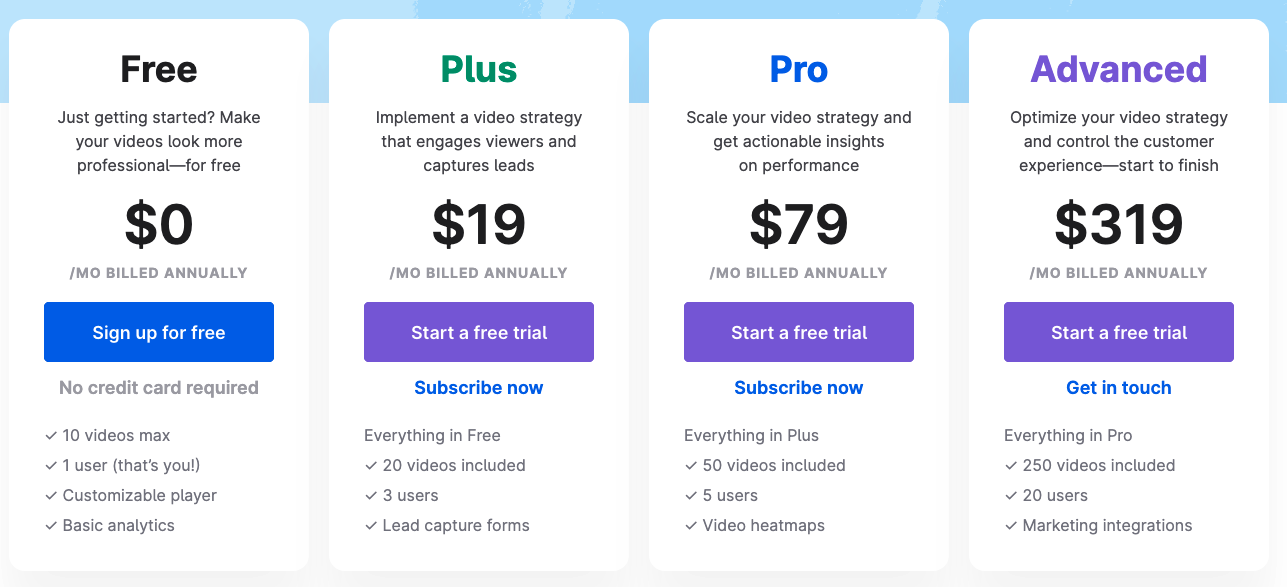Using a freemium model is now an increasingly popular tactic for SaaS companies. Highly successful companies like Dropbox, MailChimp, Zoom and Canva all offer a “free-forever” plan with limited features to generate interest and attract potential customers.
And while freemium is an effective way to get people to use your product, this model is only effective if you convert a percentage of free plan users into paying customers.
But convincing free users to pull out their credit cards isn’t easy — which is why SaaS companies are struggling with freemium-to-paid conversion rates that hover around 8-10%.
What do the most successful freemium companies do to beat the benchmarks and increase their conversion rate?
Let’s take a look at 10 companies that are slaying the freemium model to achieve success on a high level.
1. Wistia
Video marketing platform Wistia offers a free plan that enables users to create, host and market up to 10 videos per month, and includes a customizable player. However, Wistia watermarks all the videos on the free plan with their logo.
To remove the Wistia branding and access advanced features like lead capture forms and password protection, users need to upgrade to one of Wistia’s paid plans.

2. Zoom
Zoom was already popular before the pandemic hit, but its freemium model really hit its stride during lockdowns when people needed a way to connect online with friends, family and colleagues.
In an interview with SaaSStr, Zoom CEO Eric Yuan said, “We make our freemium work so well. We give most of our features for free and one-to-one is no limitation. That’s why almost every day there are so many users coming to our website, free users. If they like our product, very soon they are going to pay for the subscription.”
The brilliance of Zoom’s model is that virality is baked in. Freemium users who want to try out the product invite people in their network to try it out, too — and a viral effect happens naturally as people fall in love with Zoom’s user experience.
3. Dropbox
New freemium Dropbox users can get up to 2GB of storage at no charge, but this limit puts a big cap on Dropbox’s usefulness for most users.
To upgrade, Dropbox users can choose between various personal and professional plans that offer more storage, better backup and administrative features, and customer support.
4. Canva
Canva offers users free access to their sophisticated graphic design and editing tools. Users can create social media images, website banners and more with their easy-to-use platform that includes thousands of stock images and hundreds of templates.
Upgrading to Canva Pro gives users even more templates and stock images, as well as a variety of branding tools. With paid plans, Canva also provides 24/7 technical support.
Clearly, Canva’s freemium model is working. The company currently has over 5 million Pro customers and is valued at $40 billion.
5. Livestorm
When users sign up for the video conferencing and webinar software platform Livestorm, they can run sessions of up to 20 minutes (with up to 10 participants) for free. To run larger and longer webinars or meetings, users need to upgrade to one of the Pro, Business or Enterprise plans.
The secret to Livestorm’s success is their automated freemium onboarding emails, which are personalized for each user and highlight the platform’s most important features.
Thibaut Davoult, Head of Growth at Livestorm, told Databox, “We have a reactivation campaign that sends emails to free users who stopped signing in. The goal here is to reactivate them or motivate them to invite their teammates in the hopes that they will become champions of our solution in their companies and nudge their teams toward purchase…we’ve relentlessly automated and personalized each message that our free users receive after they sign up.”
6. Heap
Digital insights platform Heap focuses on nurturing its freemium users and empowering them to make their lives easier by using the tool. They convert free users to paying customers by using tutorials and in-app guides to show how powerful their premium version is.
7. Webflow
Webflow is a no-code software platform that helps people design and build complex websites and web applications.
Their free plan includes 1 GB bandwidth and publication to a Webflow.io domain. Upgrading to one of the paid plans enables Webflow customers to publish to a custom domain, get more bandwidth and add guest editors.
The company recently raised $120 million in their Series C funding round and has hit a $4 billion valuation.
8. MailChimp
For users who have an email subscriber list of under 2,000 contacts, MailChimp’s Free plan is a great deal. You can send up to 10,000 emails a month and get access to MailChimp’s suite of sign-up forms and landing page tools.
As free plan users expand their email marketing efforts, they can upgrade to the Essential plan for just $11 a month. MailChimp also offers high-volume plans for companies that send a lot of emails every month.
Clearly, many MailChimp users are sticking with the free plan, but the company is still very successful. As of September 2021, MailChimp has over 2.4 million monthly active users and 800,000 paid customers.
9. Upkeep
Asset Operations Management solution Upkeep offers a centralized command center for maintenance and reliability teams. The company’s free Community plan includes basic features like Work Order and Asset Management, but users need to upgrade to the Starter, Professional or Business Plus plans to access the platform’s advanced analytics features or API functionality.
In an interesting twist on the freemium model, Upkeep also offers users a free trial of either their Starter or Professional plans.
Ryan Chan, Upkeep’s founder and CEO, told Databox, “This essentially lets users test drive the car around with no risk and has been an effective tactic for getting users to become paid customers. When a user realizes the valuable impact of our product on their business, they have a hard time walking away from accessing the product on a longer term.”
10. Evernote
Evernote is a note-taking, document storage and task management SaaS platform that helps people organize their ideas and keep track of all the parts and pieces of their lives.
With Evernote Free, users can upload up to 60 MB every month, sync to up to 2 devices, and attach PDFs, photos and documents to their notes. Users looking for more storage and synced devices can upload to Evernote’s Personal or Professional plans for $7.99 or $9.99 a month, respectively.

Standing Tall on a SaaS Freemium Model
The value of using a freemium model to give your prospects “free-forever” access to the basic features of your SaaS platform is massive. We’ve explored some of the most successful companies that are currently using a freemium model to rocket to success in the marketplace.
You can use these model strategies to not only attract more users, but also convert more freemium prospects into loyal paying customers.
Connect with Jessica Mehring on LinkedIn to learn more about how Horizon Peak Consulting can help you create a data-driven digital marketing plan for your SaaS company.
